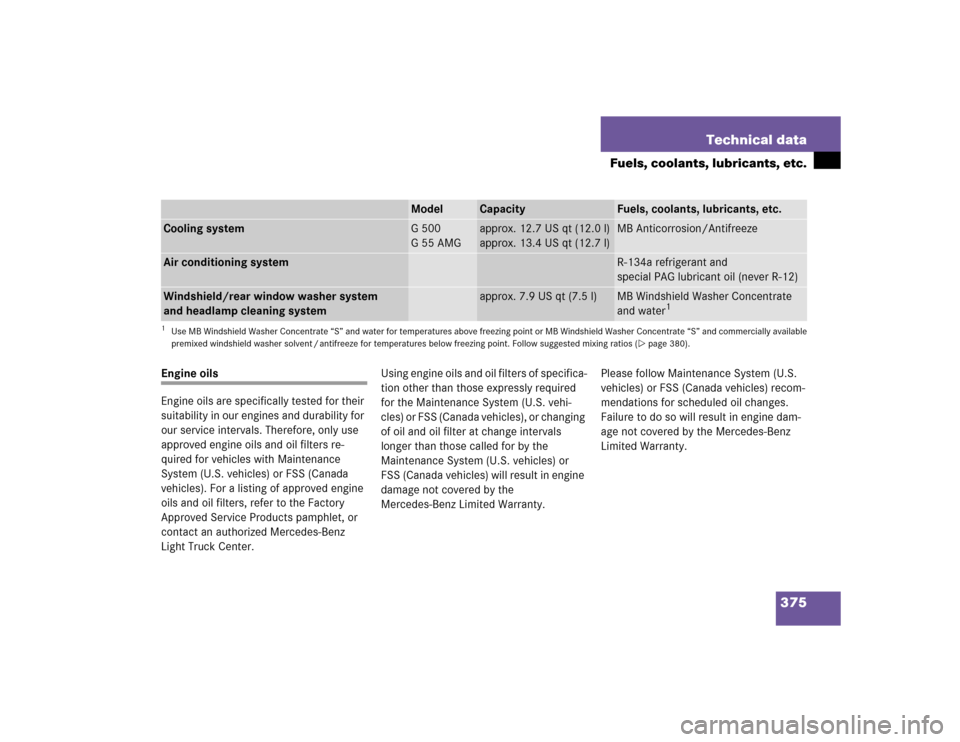Page 215 of 416
215 Operation
The first 1000 miles (1500 km)
All of the above instructions, as may apply
to your vehicle type, also apply when driv-
ing the first 1000 miles (1500 km) after the
engine, the transfer case, the front differ-
ential or the rear differential has been re-
placed.
iG55AMG:
For better protection of the front and
rear differential, the oil must be
changed after a break-in period of
1900 miles (3000 km).
Changing oil in the front and rear
differential increases the service life
and helps reduce noise from the
differential locks.
See Maintenance Booklet for additional
information and Factory Approved
Service Products pamphlet for informa-
tion on the approved service product
required to perform the front and rear
axle oil change.
iAlways obey applicable speed limits.
Page 225 of 416

225 Operation
Driving instructions
Checklist before off-road driving
Engine oil level�
Check the engine oil level
(�page 240). The display
ENGINE OIL
LEVEL - OK
must appear in the multi-
function display.
Only then can the vehicle obtain a trou-
ble-free oil supply, even on steep gradi-
ents.
Tires
�
Check the tread depth and maintain
specified tire inflation pressure
(a placard with the recommended tire
inflation pressures is located on the
driver’s door B-pillar (
�page 251)).
�
Check tires for possible damage and
remove foreign objects.
�
Replace missing valve caps.Rims
�
Dented or bent rims can cause tire in-
flation pressure loss and damage the
tire beads. For this reason, check and,
if necessary, change rims before driv-
ing off-road.
Vehicle tool kit
�
Check if the vehicle jack is functional.
�
In all cases take the vehicle tool kit, a
strong tow rope, a shovel and a small
plank (to put under the vehicle jack on
sandy soil) with you.
�
Avoid excessive engine
speeds – drive at moderate engine
speeds (max. 3000 rpm).
�
Before driving through water, deter-
mine its depth.
�
Do not stop vehicle while immersed
in water, and do not shut off the en-
gine.
�
In sandy soil, drive at a steady
speed as allowed by conditions.
This helps overcome the vehicle
rolling resistance and reduces the
likelihood of the vehicle sinking into
the ground.
�
Do not initiate jumps with the vehi-
cle. It interrupts the forward mo-
mentum of the vehicle.
�
Always drive on slopes with the en-
gine running and the vehicle in
gear.
�
Inspect the vehicle for possible
damage after each off-road trip.
Page 243 of 416

243 Operation
Engine compartment
Adding engine oil
Only use approved engine oils and oil fil-
ters required for vehicles with
Maintenance System (U.S. vehicles) or
FSS (Canada vehicles). For a listing of ap-
proved engine oils and oil filters, refer to
the Factory Approved Service Products
pamphlet in your vehicle literature portfo-
lio, or contact an authorized
Mercedes-Benz Light Truck Center.
Using engine oils and oil filters of specifica-
tion other than those expressly required
for the Maintenance System (U.S. vehi-
cles) or FSS (Canada vehicles), or changing
of oil and oil filter at change intervals long-
er than those called for by the
Maintenance System (U.S. vehicles) or
FSS (Canada vehicles) will result in engine
damage not covered by the
Mercedes-Benz Limited Warranty.
G5001Oil dipstick
2Oil filler cap
G55AMG1Oil dipstick
2Oil filler cap�
Unscrew oil filler cap2 from filler
neck.
�
Add engine oil as required. Be careful
not to overfill with oil.
Be careful not to spill any oil when adding.
Avoid environmental damage caused by oil
entering the ground or water.
��
Page 375 of 416

375 Technical data
Fuels, coolants, lubricants, etc.
Engine oils
Engine oils are specifically tested for their
suitability in our engines and durability for
our service intervals. Therefore, only use
approved engine oils and oil filters re-
quired for vehicles with Maintenance
System (U.S. vehicles) or FSS (Canada
vehicles). For a listing of approved engine
oils and oil filters, refer to the Factory
Approved Service Products pamphlet, or
contact an authorized Mercedes-Benz
Light Truck Center.Using engine oils and oil filters of specifica-
tion other than those expressly required
for the Maintenance System (U.S. vehi-
cles) or FSS (Canada vehicles), or changing
of oil and oil filter at change intervals
longer than those called for by the
Maintenance System (U.S. vehicles) or
FSS (Canada vehicles) will result in engine
damage not covered by the
Mercedes-Benz Limited Warranty.Please follow Maintenance System (U.S.
vehicles) or FSS (Canada vehicles) recom-
mendations for scheduled oil changes.
Failure to do so will result in engine dam-
age not covered by the Mercedes-Benz
Limited Warranty.
Model
Capacity
Fuels, coolants, lubricants, etc.
Cooling system
G 500
G55AMG
approx. 12.7 US qt (12.0 l)
approx. 13.4 US qt (12.7 l)
MB Anticorrosion/Antifreeze
Air conditioning system
R-134a refrigerant and
special PAG lubricant oil (never R-12)
Windshield/rear window washer system
and headlamp cleaning system
approx. 7.9 US qt (7.5 l)
MB Windshield Washer Concentrate
and water
1
1Use MB Windshield Washer Concentrate “S” and water for temperatures above freezing point or MB Windshield Washer Concentrate “S” and commercially available
premixed windshield washer solvent / antifreeze for temperatures below freezing point. Follow suggested mixing ratios (�page 380).
Page 382 of 416

382 Technical termsCOMAND
(C
ockpit M
anagement and D
ata
System)
Information and operating center for
vehicle sound and communications
systems, including the radio and the
navigation system, as well as other op-
tional equipment (CD changer, tele-
phone, etc.).
Control system
The control system is used to call up
vehicle information and to change
component settings. Information and
messages appear in the multifunction
display. The driver uses the buttons on
the multifunction steering wheel to
navigate through the system and to ad-
just settings.
Differential locks
On slippery surfaces, differential locks
prevent one wheel of an axle from spin-
ning while the other wheel stands still,
resulting in driving force no longer be-
ing transferred.Cruise control
Driving convenience system that auto-
matically maintains the vehicle speed
set by the driver.
Curb weight
(
�page 271)
DOT
(Department o
f Transportation)
(
�page 271)
Engine number
The number set by the manufacturer
and placed on the cylinder block to
uniquely identify each engine pro-
duced.
Engine oil viscosity
Measurement for the inner friction (vis-
cosity) of the oil at different tempera-
tures. The higher the temperature an
oil can tolerate without becoming thin,
or the lower the temperature it can tol-
erate without becoming viscous, the
better the viscosity.ESP
(E
lectronic S
tability Pr
ogram)
Improves vehicle handling and direc-
tional stability.
ETD
(E
mergency T
ensioning D
evice)
Device which deploys in certain frontal
and rear collisions exceeding the sys-
tem's threshold to tighten the seat
belts.
->SRS
FSS (Canada vehicles)
(F
lexible S
ervice S
ystem)
Maintenance service indicator in the
speedometer display that informs the
driver when the next vehicle mainte-
nance service is due. FSS evaluates en-
gine temperature, oil level, vehicle
speed, engine speed, distance driven
and the time elapsed since your last
service, and calls for the next mainte-
nance service accordingly.